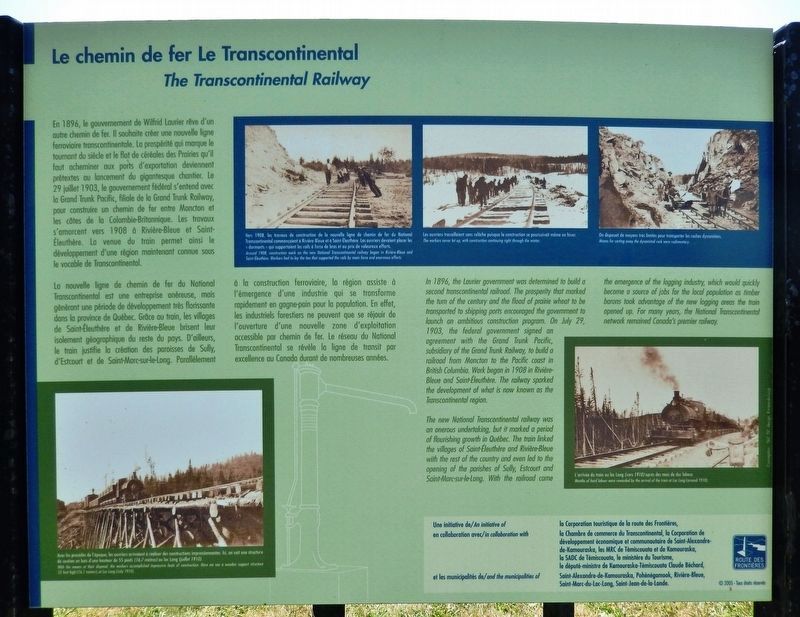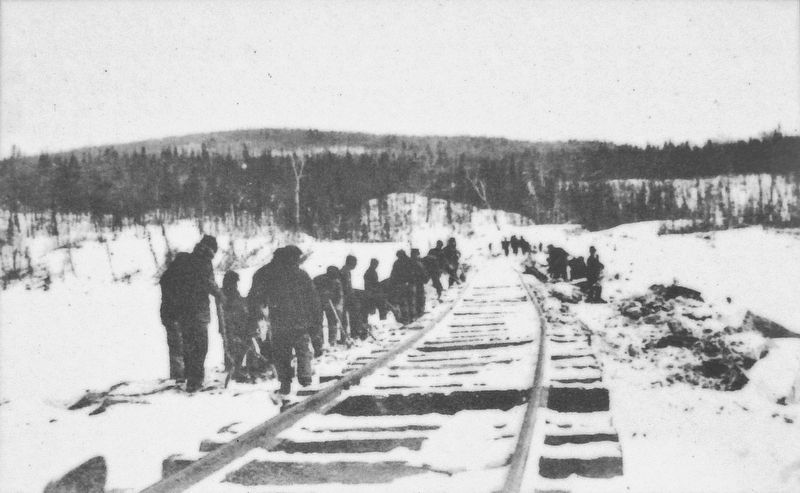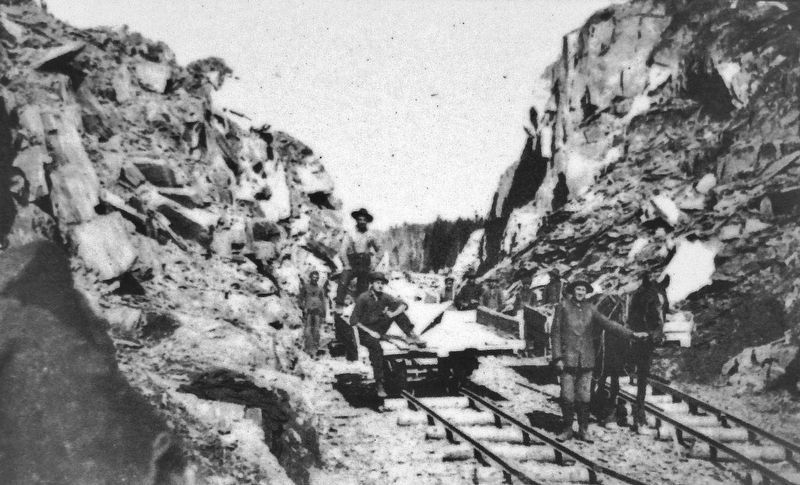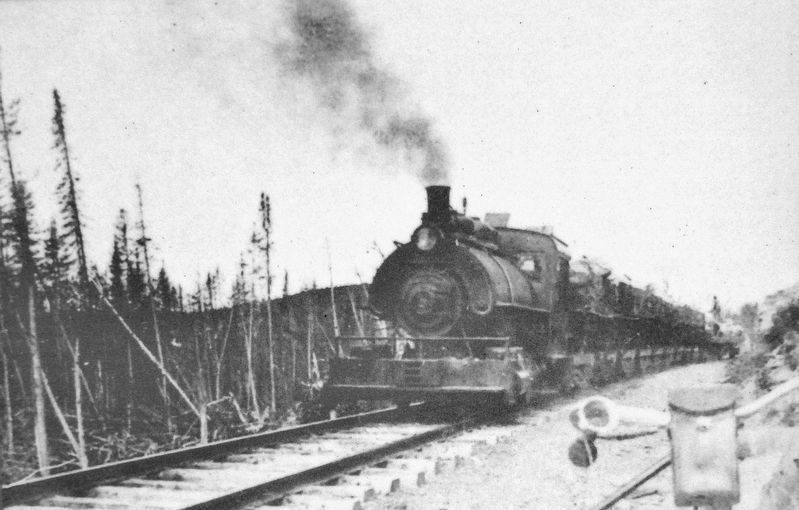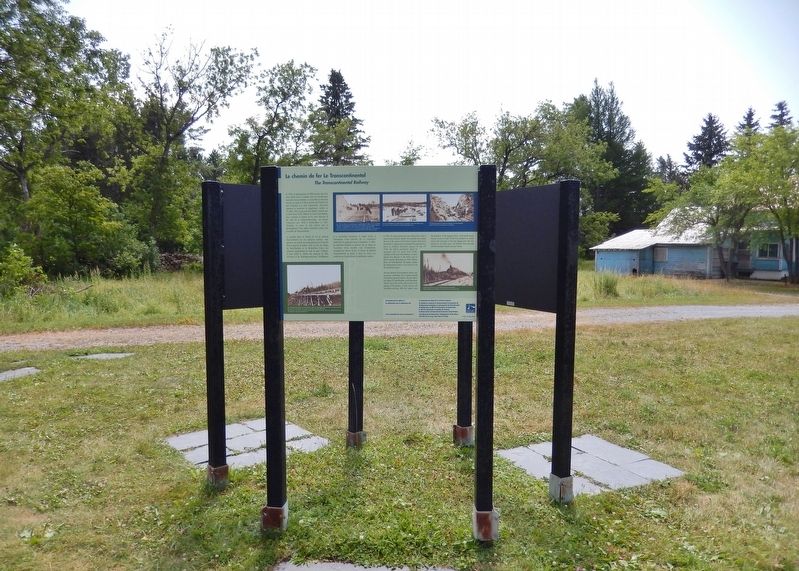Pohénégamook in Témiscouata, Québec — Central Canada (French-Canadian)
Le chemin de fer Le Transcontinental / The Transcontinental Railway
Inscription.
En 1896, le gouvernement de Wilfrid laurier rêve d'un autre chemin de fer. Il souhaite créer une nouvelle ligne ferroviaire transcontinentale. La prospérité qui marque le tournant du siècle et le flot de céréales des Prairies qu'il faut acheminer aux ports d'exportation deviennent prétextes au lancement du gigantesque chantier. Le 29 juillet 1903, le gouvernement fédéral s'entend avec la Grand Trunk Pacific, filiale de la Grand Trunk Railway, pour construire un chemin de fer entre Moncton et les côtes de la Colombie-Britannique. Les travaux s'amorcent vers 1908 à Rivière-Bleue et Saint-Éleuthère. La venue du train permet ainsi le développement d'une région maintenant connue sous le vocable de Transcontinental.
La nouvelle ligne de chemin de fer du National Transcontinental est une entreprise onéreuse, mois générant une période de développement très florissante dans la province de Québec. Grâce au train, les villages de Saint-Éleuthère et de Rivière-Bleue brisent leur isolement géographique du reste du pays. D'ailleurs, le train justifie la création des paroisses de Sully, d'Estcourt et de Saint-Marc-sur-le-Long. Parallèlement à la construction ferroviaire, la région assiste à l'émergence d'une industrie qui se transforme rapidement en gagne-pain pour la population. En effet, les industriels forestiers ne peuvent que se réjouir de l'ouverture d'une nouvelle zone d'exploitation accessible par chemin de fer. Le réseau du National Transcontinental se révèle la ligne de transit par excellence au Canada durant de nombreuses années.
In 1896, the Laurier government was determined to build a second transcontinental railroad. The prosperity that marked the turn of the century and the flood of prairie wheat to be transported to shipping ports encouraged the government to launch an ambitious construction program. On July 29, 1903, the federal government signed an agreement with the Grand Trunk Pacific, subsidiary of the Grand Trunk Railway, to build a railroad from Moncton to the Pacific coast in British Columbia. Work began in 1908 in Rivière-Bleue and Saint-Éleuthère. The railway sparked the development of what is now known as the Transcontinental region.
The new National Transcontinental railway was an onerous undertaking, but it marked a period of flourishing growth in Québec. The train linked the villages of Saint-Éleuthère and Rivière-Bleue with the rest of the country und even led to the opening of the parishes of Sully, Estcourt and Saint-Marc-sur-le-Long.
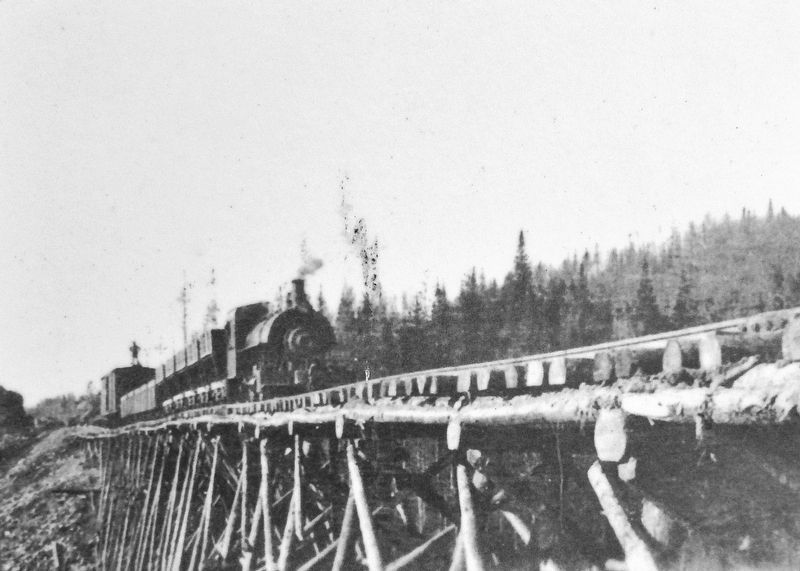
2. Marker detail: Support Structure at Lac Long, July 1910
Avec les procédés de l'époque, les ouvriers arrivaient à réaliser des constructions impressionnantes. Ici, on voit une structure de soutien en bois d'une hauteur de 55 pieds (16,7 mètres) au lac Long (juillet 1910).
With the means at their disposal, the workers accomplished impressive feats of construction. Here we see a wooden support structure 55 feet high (16.7 meters) at Lac Long (Ju1y 1910).
With the means at their disposal, the workers accomplished impressive feats of construction. Here we see a wooden support structure 55 feet high (16.7 meters) at Lac Long (Ju1y 1910).
Erected by Route des Frontières, MRC de Témiscouata, and Ville de Pohénégamook.
Topics. This historical marker is listed in these topic lists: Industry & Commerce • Railroads & Streetcars.
Location. 47° 27.573′ N, 69° 13.475′ W. Marker is in Pohénégamook, Québec, in Témiscouata. Marker can be reached from Rue de la Frontière, half a kilometer north of Rue Principale (Québec Route 289) when traveling north. Marker is located in Parc de la frontière (Frontier Park). This marker is the west-facing panel of a three-panel, triangular kiosk. Touch for map. Marker is at or near this postal address: 1161 Rue de la Frontière, Pohénégamook QC G0L 1J0, Canada. Touch for directions.
Other nearby markers. At least 5 other markers are within 14 kilometers of this marker, measured as the crow flies. Le bootlegging dans le Transcontinental / Bootlegging in the Transcontinental Region (here, next to this marker); La frontière canado-américaine / The Canada-USA Border (here, next to this marker); Le Pont International / The International Bridge
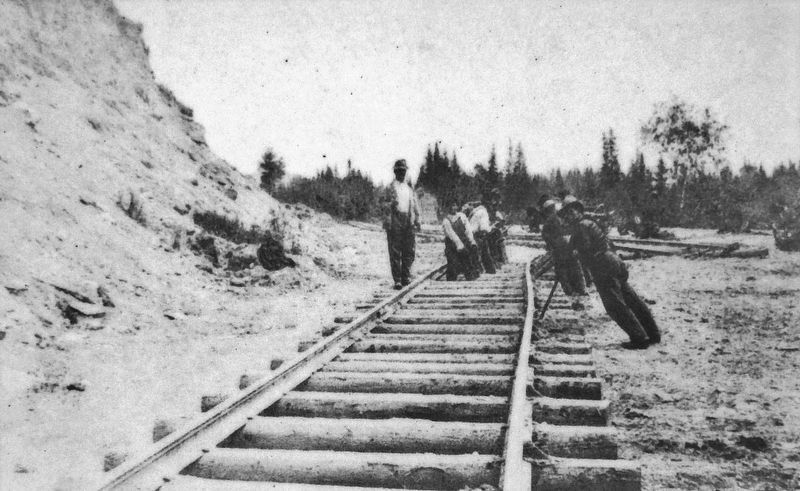
3. Marker detail: National Transcontinental Railway Contruction, 1908
Vers 1908, les travaux de construction de la nouvelle ligne de chemin de fer du National Transcontinental commençaient à Rivière-Bleue et à Saint-Éleuthère. Les ouvriers devaient placer les « dormants » qui supportaient les rails à force de bras et au prix de valeureux efforts.
Around 1908, construction work on the new National Transcontinental railway, began in Rivière-Bleue and Saint-Éleuthère. Workers had to lay the ties that supported the rails by main force and enormous efforts.
Around 1908, construction work on the new National Transcontinental railway, began in Rivière-Bleue and Saint-Éleuthère. Workers had to lay the ties that supported the rails by main force and enormous efforts.
Related markers. Click here for a list of markers that are related to this marker. Parc de la frontière (Frontier Park)
Credits. This page was last revised on November 17, 2019. It was originally submitted on November 17, 2019, by Cosmos Mariner of Cape Canaveral, Florida. This page has been viewed 261 times since then and 9 times this year. Photos: 1, 2, 3, 4, 5, 6, 7. submitted on November 17, 2019, by Cosmos Mariner of Cape Canaveral, Florida.
